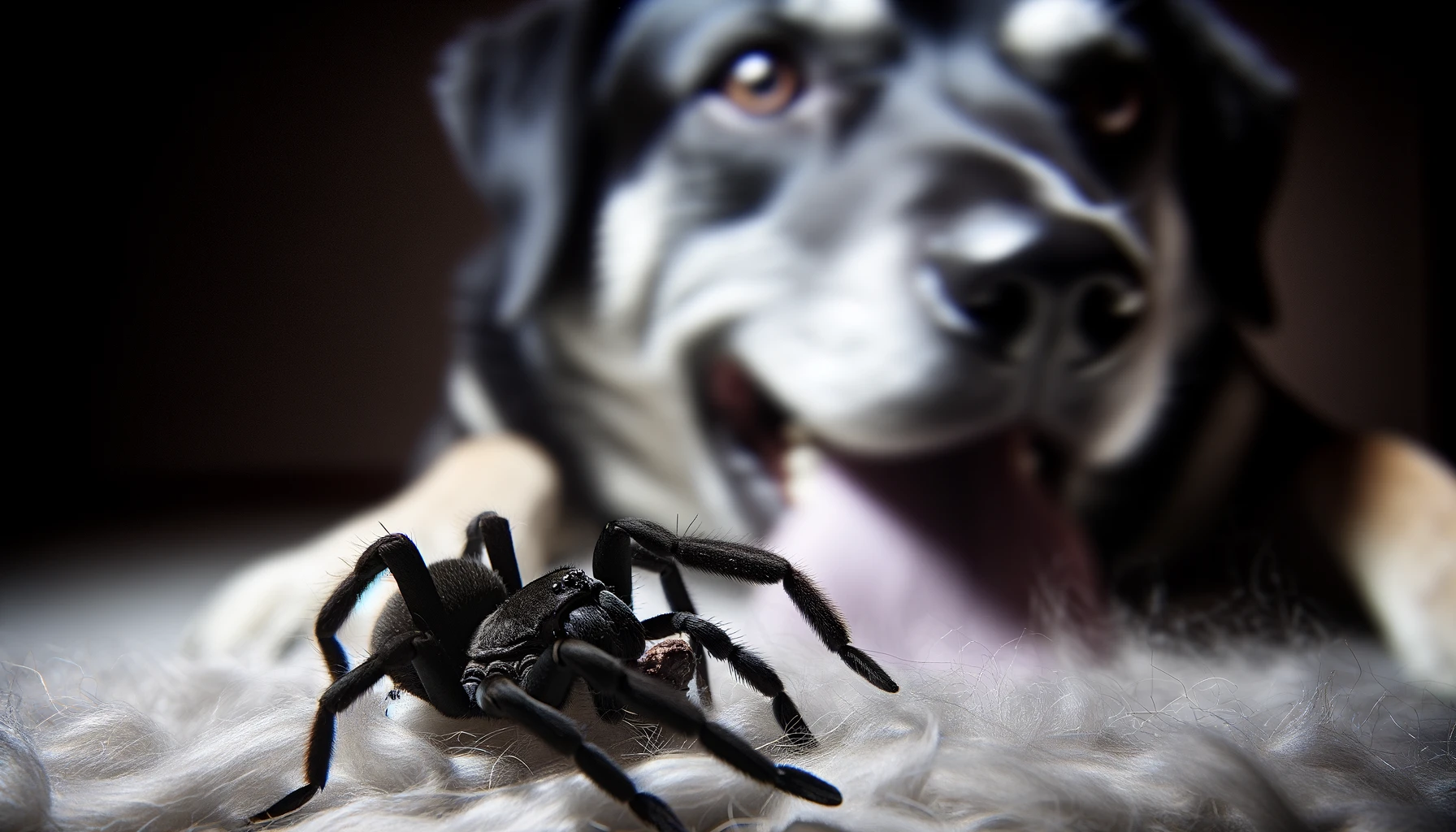
4, Mar 2024
What to Do if a Black House Spider Bites Your Dog
Finding out that your dog has been bitten by a black house spider can be worrying. Although black house spiders aren’t usually thought to be extremely toxic to people, their effects on canines can differ. To protect your pet’s health and safety, you must act quickly and intelligently. If you find yourself in this circumstance, there are important actions and preventative measures you may do according to this article.
Key Takeaways
- Immediate cleaning of the bite area and monitoring for symptoms is crucial.
- Consultation with a vet is recommended if any adverse reactions are observed.
- Preventive measures can reduce the risk of spider bites.
(TOC)
- Introduction
- Immediate Actions to Take
- Cleaning the Bite
- Monitoring Symptoms
- When to Consult a Vet
- Preventive Measures
- Understanding Black House Spiders
- Frequently Asked Questions
Immediate Actions to Take
Cleaning the Bite
The first step after identifying a spider bite on your dog is to clean the area thoroughly. Use mild soap and warm water to gently wash the bite site, which can help prevent infection and reduce the risk of complications.
- Gently press the area to remove any spider venom.
- Apply a cold pack to reduce swelling and discomfort.
Monitoring Symptoms
Closely observe your dog for any signs of adverse reactions following the bite. Symptoms can vary but may include swelling, redness, itching, or more severe reactions such as difficulty breathing, muscle weakness, or lethargy.
- Note any changes in behavior or health.
- Record symptoms to inform your vet if necessary.
When to Consult a Vet
If your dog shows any signs of distress or allergic reaction, it is imperative to consult a vet immediately. They can provide professional care and specific treatments such as antivenom, pain relief, or antibiotics to prevent infection.
- Seek immediate veterinary care for severe reactions.
- Follow the vet’s recommendations for treatment and care.
Preventive Measures
Taking steps to minimize the presence of spiders in and around your home can help protect your dog from future bites. Regular cleaning, sealing cracks and crevices, and using natural spider repellents can make your environment less inviting to spiders.
- Maintain a clean and clutter-free environment to deter spiders.
- Use natural repellents like peppermint oil around your home.
Understanding Black House Spiders
Understanding the behavior and habitat of black house spiders can aid in preventing encounters. These spiders typically prefer dark, secluded areas and are not aggressive by nature but will bite if threatened or accidentally pressed against the skin.
- Non-aggressive towards pets and humans but will defend themselves.
- Prefer to reside in undisturbed areas of the home.
Frequently Asked Questions
Do black house spiders pose a danger to dogs?
- Generally, black house spider bites are not lethal to dogs but can cause discomfort and localized reactions. Always monitor your pet closely and consult a vet if you notice any concerning symptoms.
Can spider bites cause long-term harm to my dog?
- Most spider bites, including those from black house spiders, do not cause long-term harm to dogs if treated promptly. Severe reactions are rare but possible, emphasizing the importance of veterinary consultation.
What are the signs of a spider bite on dogs?
- Signs can include a small puncture wound, swelling, redness, and signs of pain or itching. In some cases, systemic symptoms like lethargy or changes in behavior can occur.
- 0
- By Faizan Khan
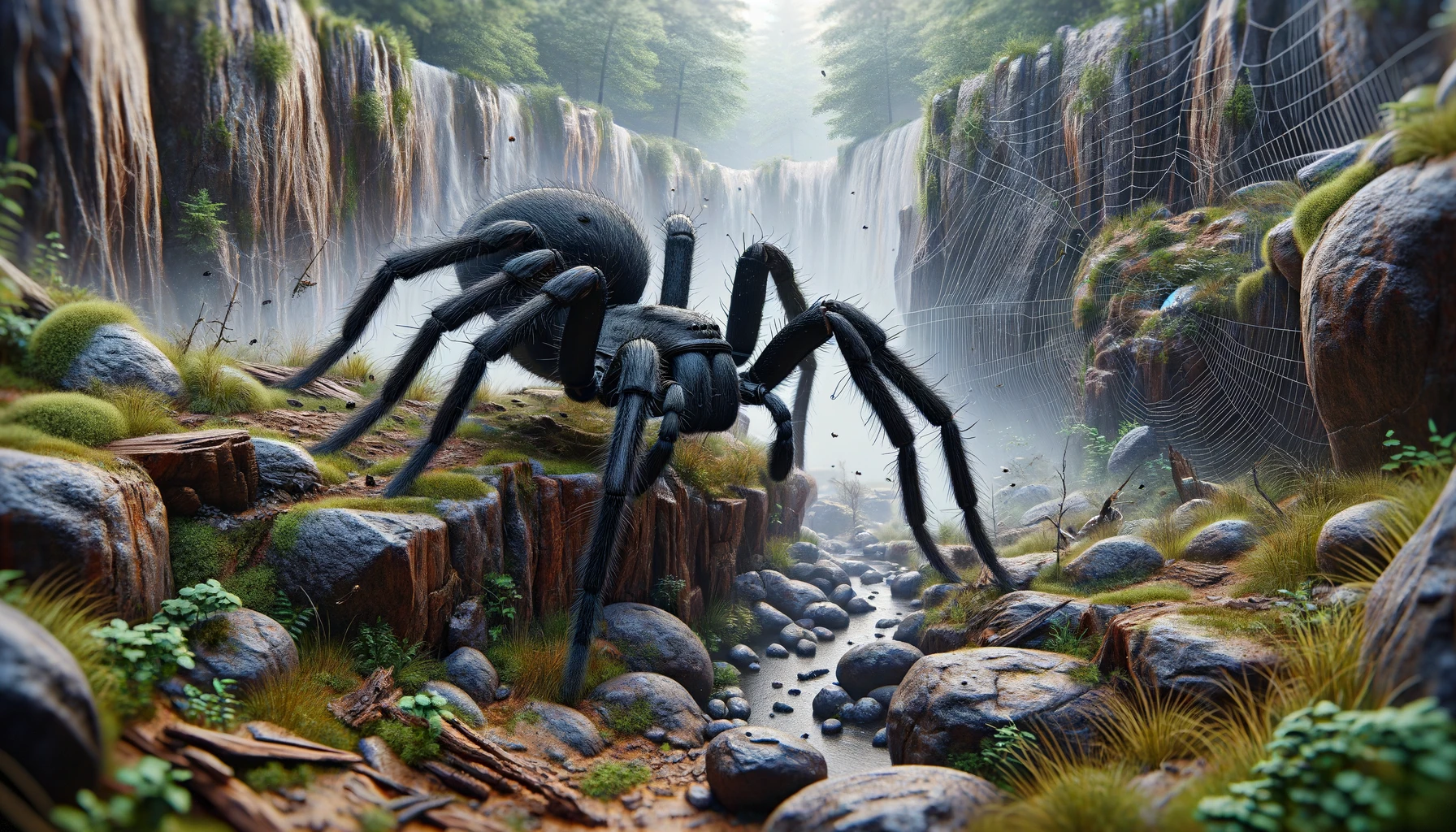
1, Mar 2024
The Habitat Preferences of the Black House Spider
The Black House Spider (Badumna insignis) is a species of spider commonly found in Australia and New Zealand, renowned for its distinctive webbing and preference for residing in human dwellings and other structures. Understanding the habitat preferences of the Black House Spider is crucial for both managing their presence in human environments and appreciating the ecological roles they play. This article delves into the natural habitats, behavioral patterns, and ecological significance of these spiders, providing insights for enthusiasts and homeowners alike.
Key Takeaways
- Black House Spiders prefer dark and sheltered environments.
- They are commonly found in window frames, wall crevices, and under eaves.
- Their webs are messy and funnel-shaped, serving as effective traps for prey.
- Understanding their habitat preferences can help in managing their presence around homes.
(TOC)
- Introduction
- Natural Habitats
- Adaptation to Urban Environments
- Web Structure and Location Preferences
- Behavioral Patterns
- Ecological Significance
- Frequently Asked Questions
Natural Habitats
Black House Spiders thrive in a variety of natural environments, from forests to scrublands, demonstrating a strong preference for spaces that offer protection from the elements and a steady food supply. These spiders are particularly fond of occupying tree trunks, rock walls, and any natural crevices they can find.
Adaptation to Urban Environments
As urban areas expand, Black House Spiders have shown remarkable adaptability in colonizing new environments. They are commonly found in residential areas, making homes in window frames, doorways, and other man-made structures. This adaptability highlights their preference for dark, sheltered spaces, even in urban settings.
Urban Habitat Table
| Location | Description |
| Window Frames | Dark, sheltered, and abundant prey |
| Wall Crevices | Protection from predators |
| Under Eaves | Ideal for web construction |
Web Structure and Location Preferences
Black House Spiders construct distinctive, messy, funnel-shaped webs that serve as both homes and traps for prey. The placement of these webs is strategic, maximizing the spider’s chances of capturing insects while minimizing exposure to predators.
Behavioral Patterns
Understanding the behavioral patterns of Black House Spiders is key to appreciating their habitat preferences. These spiders are predominantly nocturnal, hunting during the night and retreating to the safety of their webs by day. Their sedentary lifestyle means they rarely venture far from their webs, relying on the strategic placement of their homes to capture food.
Ecological Significance
Black House Spiders play a crucial role in their ecosystems, acting as both predators and prey. Their presence in urban environments can also be beneficial, helping control insect populations around homes.
Frequently Asked Questions
What do Black House Spiders eat?
Black House Spiders primarily feed on insects such as flies, moths, and other small arthropods caught in their webs.
Are Black House Spiders dangerous?
While they can bite in self-defense, their venom is not considered dangerous to humans, typically resulting in localized pain or swelling.
How can I safely remove a Black House Spider from my home?
Gently coaxing the spider onto a piece of paper or into a jar and releasing it outside is a humane method for removal.
Advanced Insights into Black House Spider Behavior
Recent studies have shed light on the complex behaviors of Black House Spiders, including their hunting tactics, mating rituals, and territorial disputes. Understanding these behaviors provides deeper insights into their habitat preferences.
Table: Behavioral Insights of Black House Spiders
| Behavior | Description |
| Hunting Technique | Ambush predators, relying on their webs to trap prey |
| Mating Rituals | Males perform delicate courtship dances to avoid being mistaken for prey |
| Territoriality | Females are highly territorial, seldom leaving their webs |
This article has explored the habitat preferences of the Black House Spider, highlighting their adaptability, ecological significance, and the importance of coexistence with humans. From their natural habitats to their behavior and contributions to biodiversity, it’s clear that these spiders are integral to our ecosystems.

10, Jan 2024
Can I Kill a Black House Spider?
“Can I kill Black House Spiders?” This question often arises in households, especially when encountering these common arachnids. The Black House Spider (Badumna insignis), a species that is common in metropolitan settings, especially in Australia, arouses curiosity as well as dread. We will examine some issues related to Black House Spiders in this detailed guide, such as identification, habitat, behavior, possible health hazards, and moral management techniques.
Identifying Black House Spiders: Characteristics and Habitats
To effectively manage Black House Spiders, identifying them correctly is crucial. Their dark coloring, which includes a charcoal grey abdomen with white markings and a carapace and legs ranging from dark brown to black, makes them distinctive. Females are usually larger, measuring between 14 and 15 mm on average.
Habitats: Where Do They Thrive?
These spiders favor sheltered areas such as window frames, gutters, brickwork, and even natural settings like rough-barked trees. Understanding their preferred habitats can aid in effective management and prevention strategies.
Understanding Their Diet and Lifecycle
Black house spiders are important members of the environment since they mostly eat other insects including ants, beetles, and flies. Their life cycle, which includes silk egg sac production and mating rituals, is an interesting facet of their behavior.
Addressing Health Concerns: Are Black House Spider Bites Dangerous?
Black House Spiders are generally not hostile toward humans, even though their bites can inflict pain and swelling, and their venom is not fatal. Understanding this can alleviate unnecessary fear and promote more humane management methods.
Ethical Management: Alternatives to Killing
Humane Removal Techniques
- Gentle Relocation: Safely capturing and relocating these spiders to an outdoor environment is a compassionate approach.
- Preventive Measures: Seal entry points and maintain cleanliness to deter spiders from entering.
DIY Solutions: Natural Repellents and Spider-Proofing
- Natural Repellents: Utilize household items to create effective spider deterrents.
- Spider-Proofing Your Home: Regularly inspect and maintain areas where spiders are likely to inhabit.
Professional Spider Management
When DIY methods aren’t enough, professional pest control can offer safe and ethical solutions, prioritizing humane treatment and environmental conservation.
The Role of Black House Spiders in Our Ecosystem
Acknowledging Black House Spiders’ ecological function in managing pest populations can help us go from fear to appreciation and promote a more peaceful relationship.
Conclusion:
In conclusion, considering the ecological importance of Black House Spiders and their generally unnoticed attitude, it is reasonable to wonder if killing them is appropriate. However, investigating humane management techniques is both responsible and beneficial. With any luck, this book will provide you with the information and resources you need to make wise choices and live in safety and civility with these amazing animals.

2, Jan 2024
Black Wolf Spider VS Black House Spider
The Black House Spider and Black Wolf Spider are two species that stick out in the complex world of spiders due to their unique traits. We go on a quest to comprehend the subtleties that distinguish these arachnids in this investigation, highlighting how crucial it is to acknowledge and appreciate their responsibilities in our environment.
Identification and Characteristics:
Physical Features of Black Wolf Spider
The Black Wolf Spider, a formidable hunter, showcases a robust build and distinctive coloration. With a size ranging from moderate to large, these spiders often exhibit unique markings, adding to their individuality.
Physical Features of Black House Spider
Contrastingly, the Black House Spider, while sharing a dark coloration, is characterized by a more delicate build. Typically smaller than their wolf spider counterparts, they are known for their intricate web structures, setting them apart in the arachnid world.
Habitat and Distribution:
Preferred Environments for Black Wolf Spiders
Black Wolf Spiders are predominantly outdoor inhabitants, favoring natural environments such as gardens, meadows, and wooded areas. They construct nests and hide in vegetation, adapting well to diverse outdoor landscapes.
Preferred Environments for Black House Spiders
However, Black House Spiders are more adaptable, living happily in both indoor and outdoor environments. Their favorite places to live are dark nooks and crannies indoors, and gardens and sheds outside provide good habitats.
Behavior and Hunting Strategies:
Hunting Behaviors of Black Wolf Spiders
Black Wolf Spiders are known for their active hunting strategies, relying on speed and agility to chase down prey. They prefer to stalk and pounce on insects, displaying a more dynamic approach to feeding.
Hunting Behaviors of Black House Spiders
In contrast, Black House Spiders employ web-building strategies to capture prey. They patiently wait for insects to become entangled in their intricately crafted webs, showcasing a more passive yet effective hunting technique.
Venom and Potential Harm:
Overview of Venomous Characteristics in Black Wolf Spiders
While both spiders possess venom, Black Wolf Spiders are generally not considered highly venomous to humans. Their venom aids in subduing prey, and their bites, though rare, are usually mild and do not pose significant harm.
Overview of Venomous Characteristics in Black House Spiders
Similarly, Black House Spiders are not known for causing severe harm to humans. Their venom is primarily designed for prey capture, and bites, while uncomfortable, typically do not result in serious medical issues.
Potential Harm to Humans and Pets
If any species does bite someone, first aid treatments like washing the bite site and using a cold compress are usually enough. It is best to seek medical assistance only in rare instances of severe reactions.
Coexistence and Pest Control:
Tips for Coexisting with Black Wolf Spiders
For those sharing outdoor spaces with Black Wolf Spiders, maintaining a respectful distance and avoiding direct confrontation is key. These spiders contribute positively to the ecosystem by controlling insect populations.
Tips for Coexisting with Black House Spiders
To peacefully coexist with Black House Spiders indoors, regular cleaning and minimizing clutter are effective practices. Appreciating their role in managing household pests fosters a balanced living environment.
Non-Toxic Pest Management Techniques for Every Species
One way to manage bug populations without harming spiders is to use non-lethal pest control techniques, including natural repellents or traps.
Typical Myths:
Dispelling Myths about Black Wolf Spiders
Misconceptions often surround Black Wolf Spiders, with some fearing their presence. By providing accurate information, we aim to dispel myths and promote a more informed and appreciative perspective.
Dispelling Myths about Black House Spiders
Similarly, misconceptions about Black House Spiders contribute to unwarranted fears. Clarifying their role in ecosystems and their minimal threat to humans helps foster a more positive outlook.
Conclusion:
It is clear from navigating the webs of the Black House and Wolf Spiders that each species has a distinct and important function to perform in the natural order. It is possible for us to live in harmony with these amazing spiders if we comprehend their traits, habits, and differences.

1, Jan 2024
Black House Spider Michigan
Many species of wildlife, including the frequently disregarded black house spider, can be found in Michigan, a state rich in natural diversity. We examine the traits, habits, and cohabitation techniques unique to the black house spider in Michigan in this investigation, illuminating the species’ crucial function in the regional ecology.
Identification and Characteristics:
Physical Features of Black House Spiders in Michigan
In the corners and crevices of Michigan homes, the black house spider boasts a distinctive appearance. Sized from small to medium, these spiders exhibit a dark coloration that aids in their discreet presence. Examining their intricate web structures reveals the unique patterns that set them apart in the local arachnid community.
Habitat and Distribution:
Preferred Environments for Black House Spiders in Michigan
From urban homes to rural landscapes, black house spiders in Michigan exhibit adaptability. Outside they are happy in gardens, sheds, and beneath rocks; indoors they prefer dark, enclosed spaces such as attics and basements. They are distributed throughout the state, adapting to the various environments and climates Michigan has to offer.
Behavior and Diet:
Hunting and Feeding Habits Specific to Black House Spiders in Michigan
The local black house spiders engage in subtle yet effective hunting strategies. They are essential to preserving the equilibrium of the local insect population because they wait patiently for prey in their webs. Their main source of food is typical household pests, which helps to maintain a healthier atmosphere.
Interactions with Other Species in the Local Ecosystem
In the complex predator-prey dance that occurs in Michigan’s environment, these spiders live with a variety of other insects. Their interactions show a remarkable network of relationships, each of which contributes to the environment’s overall balance.
Venom and Potential Harm:
Overview of Venomous Characteristics of Black House Spiders in Michigan
While possessing venom, Michigan’s black house spiders are not considered highly venomous to humans. The venom aids in subduing prey rather than posing a significant threat to residents.
Assessment of Potential Harm to Humans and Pets
Instances of bites are rare, and their effects are generally mild. It is sufficient to use a cold compress and clean the bitten area as first aid. It is best to seek medical assistance only in rare instances of severe reactions.
First Aid and Precautions Specific to the Local Species
Understanding local first aid measures is crucial. A Michigan-specific approach to dealing with bites involves prompt and proper wound care, minimizing any potential discomfort.
Coexistence and Pest Control:
Tips for Coexisting with Black House Spiders in Michigan
Michigan residents can adopt simple practices to coexist harmoniously with black house spiders. Regular cleaning, reducing clutter, and sealing entry points help create an environment where both residents and spiders can thrive.
Non-lethal Methods of Pest Control Fit for the Local Species
Non-lethal pest management solutions are beneficial for individuals looking to strike a balance between a spider-friendly atmosphere and a pest-free home. Natural repellents and traps offer solutions that protect the health of the local population as well as spiders.
Common Misconceptions:
Dispelling Myths Related to Black House Spiders in Michigan
Myths often cast these spiders in an undeserved negative light. By providing accurate information, we aim to dispel misconceptions and foster a more informed and appreciative perspective on Michigan’s black house spiders.
Clarifying Their Role in the Local Ecosystem
Thanks to their ability to regulate insect populations, these spiders are essential to the ecosystems of Michigan. A positive perspective on their existence and contribution to the community is fostered by highlighting their significance.
Conclusion:
As we unravel the story of the black house spider in Michigan, we find a creature intricately connected to its surroundings. Understanding their characteristics, behaviors, and the local adaptations that shape them allows residents to coexist in harmony. Michigan’s black house spiders are not just residents; they are contributors to the delicate balance of nature in our great state.

1, Jan 2024
Brown and Black House Spider
The brown and black house spiders are two common house spiders that are frequently overlooked in the corners of our homes and gardens. We set out on a quest to solve the enigmas surrounding these spiders in this thorough guide, learning about their traits and habits while dispelling the myths that frequently envelop them in false beliefs.
Identification and Characteristics:
Brown House Spiders
These spiders, often overlooked due to their unassuming appearance, display a subtle brown coloration. Their modest size and delicate web structures make them adept at thriving in various indoor and outdoor environments.
Black House Spiders
In contrast, black house spiders make a bolder statement with their dark hues. Ranging in size, these spiders intricately weave webs that vary in structure, showcasing adaptability to diverse surroundings.
Habitat and Distribution:
Brown House Spiders
Brown house spiders seek out isolated areas and calm spots indoors, while they may seek cover under rocks or in vegetation outside. They are widely distributed and have adapted to a variety of environments and temperatures.
Black House Spiders
Because of their adaptability, black house spiders can be found both indoors and outside. Sheds and basements are popular examples of indoor habitats, whereas gardens and porches are good outside ones.
Behavior and Diet:
Hunting and Feeding Habits of Brown House Spiders
Brown house spiders exhibit discreet hunting behaviors, relying on their delicate webs to capture small insects like flies and ants. Their diet is centered around maintaining a balance in their immediate surroundings.
Hunting and Feeding Habits of Black House Spiders
Larger and more robust, black house spiders actively hunt a diverse array of insects. Their diet includes a broader spectrum of prey, contributing significantly to pest control in ecosystems.
Interactions with Other Species
Both brown and black house spiders engage with various insects in their habitats, sometimes establishing territories or peacefully coexisting with other species.
Venom and Potential Harm:
Overview of Venomous Characteristics
While both spiders possess venom, it’s important to note that they are not considered highly venomous to humans. Their venom primarily aids in immobilizing prey rather than posing a significant threat to people.
Potential Harm to Humans and Pets
Bites from these spiders are generally mild, causing minimal harm. Standard first aid measures, such as cleaning the bite area, suffice. Severe reactions are rare, and seeking medical attention is advisable only in such cases.
First Aid and Precautions
Basic first aid includes cleaning the bite area and applying a cold compress for relief. Monitoring for any unusual symptoms is essential, with medical attention recommended if needed.
Coexistence and Pest Control:
Tips for Coexisting
Understanding the ecological roles of brown and black house spiders can foster a peaceful coexistence. A pleasant living environment can be achieved with small changes like routine cleaning, clearing clutter, and caulking entryways.
Non-Lethal Pest Control Methods
If you’re afraid of spiders, using non-toxic pest control techniques, such as natural repellents or traps, will guarantee that undesirable insects are managed without endangering these helpful spiders.
Common Misconceptions:
Dispelling Myths
Many times, misconceptions give these spiders an unfairly bad reputation. We seek to promote a more knowledgeable and appreciative viewpoint by dispelling myths and providing correct information.
Clarifying Their Role in Ecosystems
These spiders regulate insect populations, which is vital to preserving the equilibrium of the ecosystem. A more optimistic view of their presence is encouraged by realizing their significance.
Conclusion:
Brown and black house spiders weave their distinct threads into the complex tapestry of nature. As we learn more about their traits, habits, and the essential functions they perform in our environment, we develop a fresh respect for these frequently misinterpreted arachnids. Let’s celebrate the variety they offer to our gardens and living areas so that we can promote harmony and understanding.
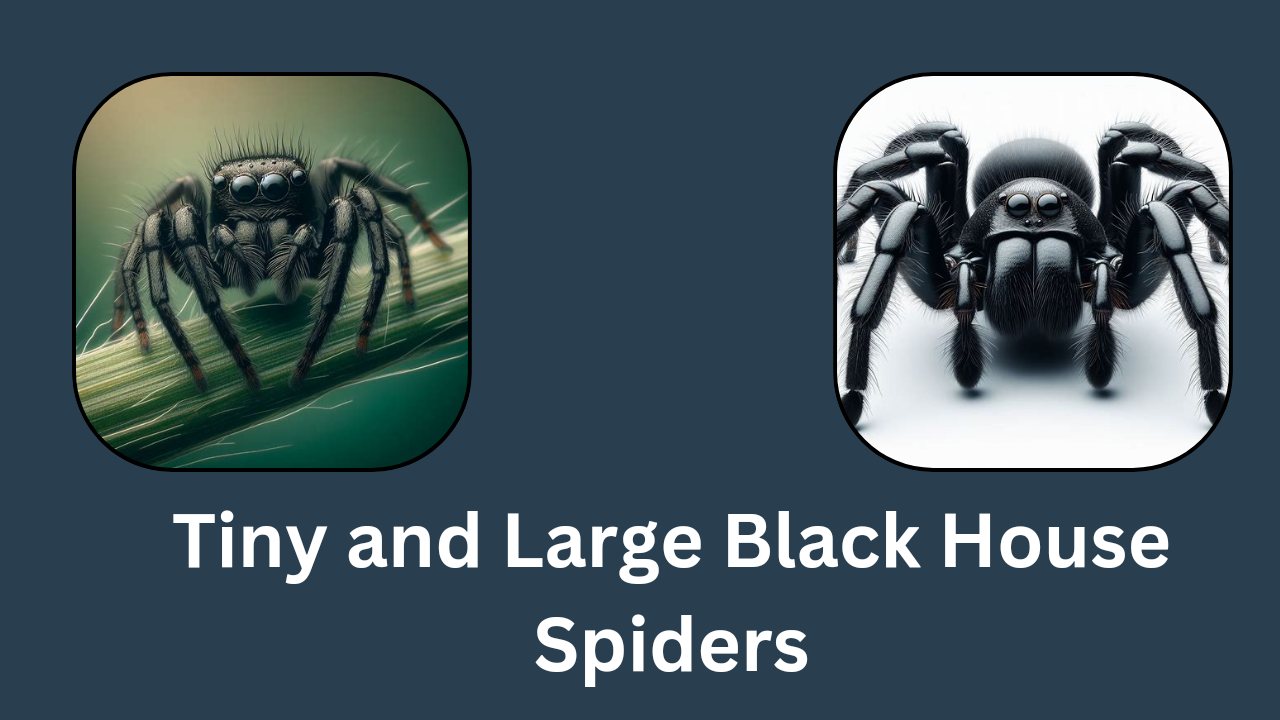
1, Jan 2024
Tiny and Large Black House Spiders
Even though they are sometimes ignored black house spiders are intriguing members of our ecosystems. These spiders are fascinating to study, from the tiny ones that secretly build elaborate webs within to their larger colleagues that create magnificent outdoor works of art. In this article, we explore the traits, habits, and cohabitation techniques of both small and giant black house spiders.
Identification and Characteristics:
Tiny Black House Spiders
These spiders, which are only a few millimeters in size, are well-known for their stealthy appearance. They disappear into nooks and crannies because of their dark color. Their intricate, yet effective, webs make the ideal trap for naive victims.
Large Black House Spiders
In contrast, their larger counterparts boast a more noticeable size, often spanning several inches. Their intricate webs, which sprawl across outdoor areas, resemble works of art. Their varied coloring, which includes tones of brown and black, helps them blend in with their natural environment.
Habitat and Distribution:
Tiny Black House Spiders
Indoors, these spiders favor cozy corners, closets, and basements. Outdoors, they may seek refuge in plants or under rocks. Adaptable to various climates, their distribution is widespread.
Large Black House Spiders
Outdoor environments, such as gardens, sheds, and porches, are the preferred domains for larger black house spiders. Factors like climate, and vegetation influence their distribution and the presence of suitable prey.
Behavior and Diet:
Hunting and Feeding Habits of Tiny Black House Spiders
These are expert hunters that use their web to snare tiny insects. They mostly eat other small arthropods like flies and mosquitoes.
Hunting and Feeding Habits of Large Black House Spiders
Larger spiders exhibit more diverse hunting strategies. They may actively hunt insects, using their size and speed to their advantage. Their diet includes a broader range of prey, contributing to ecosystem balance.
Interactions with Other Species
Both tiny and large black house spiders interact with a variety of insects. Some species may engage in territorial disputes or share spaces harmoniously, depending on their ecological niche.
Venom and Potential Harm:
Overview of Venomous Characteristics
Although they have venom, black house spiders are not thought to be extremely poisonous to humans. The main purpose of the venom is to paralyze prey, and unless provoked, spiders do not bite.
Potential Harm to Humans and Pets
Black house spider bites are usually not too painful and hardly cause serious side effects. Cleaning up the bite site and keeping an eye out for any strange symptoms are appropriate first aid procedures. On the other hand, allergic reactions can happen and call for medical intervention.
First Aid and Precautions
Cleaning the bite area with soap and water is one of the basic first aid techniques. Using a cold compress can aid in reducing edema and pain. It is advised to consult a doctor if symptoms intensify or continue.
Coexistence and Pest Control:
Importance of Understanding Ecological Role
Black house spiders feed on insects that are deemed nuisances, which helps greatly with pest control. Acknowledging their ecological function promotes a more impartial viewpoint toward their existence.
Tips for Coexisting
To live in harmony with these arachnids, keep your home clutter-free, plug any gaps or holes that could allow them access, and clean frequently. Keeping a diverse plant life and an ecosystem in balance outside promotes the existence of helpful insects.
Non-Lethal Pest Control Methods
If you’re afraid of spiders, you can control insect populations without hurting the spiders by using natural repellents or traps, which are non-lethal pest control approaches.
Common Misconceptions:
Dispelling Myths
Myths and misconceptions about black house spiders can give rise to unjustified anxieties. Clearing up these misunderstandings helps people have a more sensible and educated opinion of these helpful arachnids.
Clarifying Their Role in Ecosystems
Being aware of the essential function black house spiders play in preserving natural balance fosters a more grateful attitude. They help create a better environment by managing the population of insects.
Conclusion:
In the intricate world of black house spiders, the tiny and large species bring their unique charm and significance. An improved relationship with these intriguing spiders might result from identifying their traits, comprehending their habits, and adopting living techniques. We have a greater understanding of their significance in the complex fabric of nature as we work through the mysteries surrounding their life.
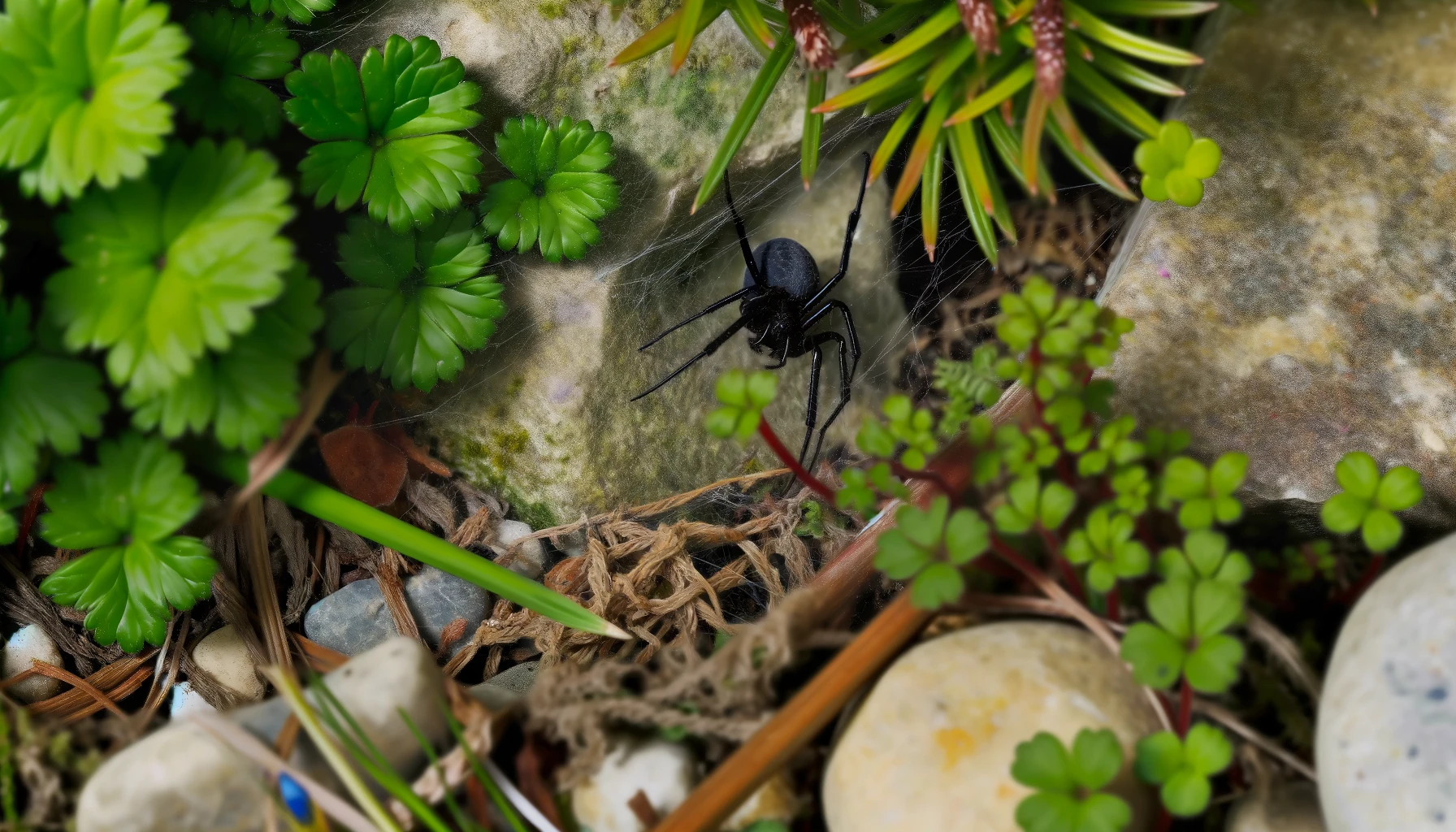
30, Dec 2023
Where Black House Spiders Thrive: Habitats Explored
The Black House Spider (Badumna insignis) is a species that evokes curiosity and, often, concern, due to its dark appearance and the commonality of its habitat in human residences. These spiders are known for their robust, velvety black or dark brown bodies and the intricate webs they weave. Understanding where they live, their behaviors, and how they interact with their environment is essential for both arachnologists and the general public.
Key Takeaways
- Black House Spiders primarily inhabit Australia and New Zealand, but they can also be found in other parts of the world due to human activity.
- They prefer dark and secluded areas, often constructing their webs in man-made structures such as window frames, sheds, and under eaves.
- Despite their menacing appearance, they are not aggressive towards humans and their bite, while venomous, is not considered dangerous.
Habitat and Distribution
The Black House Spider is predominantly found in Australia and New Zealand, thriving in both urban and rural settings. Their ability to adapt to various environments has enabled them to spread to other regions, often hitching rides in cargo and personal belongings.
Preferred Living Conditions
Black House Spiders favor locations that provide shelter and ample opportunities for catching prey. They are commonly found in:
- Corners of window frames
- Crevices in brickwork
- Under eaves and in sheds
- Inside barns and garages
Their webs are distinctive, often described as messy and funnel-shaped, designed to trap flying insects that venture too close.
Interaction with Humans
Despite their somewhat fearsome name and appearance, Black House Spiders are generally shy and avoid human interaction. The myths surrounding their danger to humans are largely unfounded. Their bite may cause discomfort but is unlikely to result in serious health issues.
Real URLs for Further Exploration
- For more information on Black House Spiders, visit the Australian Museum.
- Watch a detailed video about the life of a Black House Spider on YouTube.
Identifying a Black House Spider
Identifying a Black House Spider involves looking for several key characteristics:
- Color: Dark brown to black
- Size: Females can reach 18mm in body length, with males being smaller.
- Web: A messy, funnel-shaped web with a distinctive retreat area where the spider hides.
Understanding where Black House Spiders live and their behavior allows us to appreciate their role in the ecosystem and mitigate unwarranted fear. Their presence in our homes is more a testament to their adaptability and the shelter our buildings provide than a cause for alarm.
Managing Black House Spiders in Homes
While understanding the ecological benefits of Black House Spiders, many people prefer to keep them outside of living spaces. Here are some practical tips for managing their presence:
- Regularly clean windows, eaves, and sheds to remove webs and discourage resettling.
- Seal cracks and crevices in walls and around windows to prevent them from entering.
- Use natural repellents like peppermint oil around windows and doors.
Real URLs for Practical Advice
- Find tips and strategies for managing spiders in and around your home at PestWorld on House Spiders.
Frequently Asked Questions
Are Black House Spiders Dangerous?
Black House Spiders are often feared due to their dark appearance, but they are not considered dangerous to humans. Their bite can cause discomfort but is rarely serious.
How Can I Identify a Black House Spider?
Identify a Black House Spider by its dark color, size (with females larger than males), and the distinctive messy, funnel-shaped web with a retreat area.
Do Black House Spiders Live Alone?
Yes, Black House Spiders are solitary creatures, with each spider living and hunting alone. They only come together for mating purposes.
What Do Black House Spiders Eat?
They primarily feed on insects like flies, mosquitoes, and other small flying insects that get caught in their webs.
How Can I Prevent Black House Spiders from Entering My Home?
Prevention includes sealing entry points, keeping areas clean to discourage insect prey, and using natural repellents.
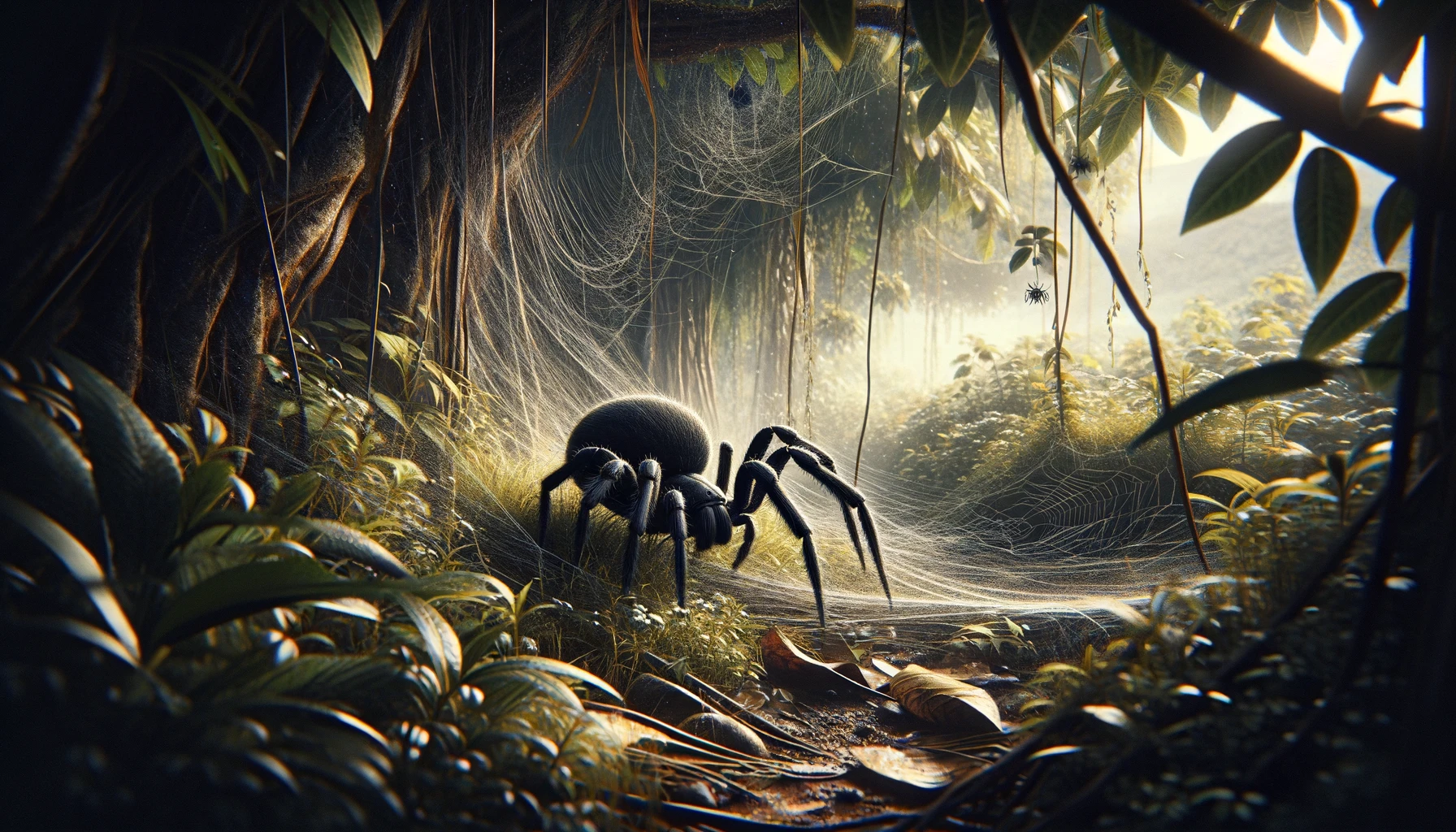
27, Dec 2023
Understanding Common Black House Spiders: A Complete Guide
Black House Spiders (Badumna insignis) are often misunderstood creatures. With their dark appearance and tendency to dwell in human residences, they can evoke unease. However, these spiders play a crucial role in our ecosystem, controlling insect populations and thus indirectly supporting human health and comfort. This guide aims to demystify these common arachnids, offering insight into their behavior, habitat, and how we can coexist with them harmoniously.
Key Takeaways
- Australia and New Zealand are home to the majority of black house spiders, though they are now found worldwide.
- They favor isolated, dark places, frequently found in homes.
- They are not aggressive toward humans, despite their appearance, and their bites are rarely dangerous.
- Understanding these spiders is key to appreciating their role in our ecosystem and mitigating any unwarranted fear.
(TOC)
- Introduction
- Habitat and Distribution
- Behavior and Diet
- Significance in the Ecosystem
- Human Interaction
- How to Manage Their Presence
Habitat and Distribution
Black House Spiders are adaptable creatures, predominantly found in Australia and New Zealand. Their distribution has expanded, however, hitching rides with human activity to reach far beyond their native lands.
- Table 1: Global Distribution of Black House Spiders
| Region | Status |
| Australia | Native |
| New Zealand | Native |
| Europe | Introduced |
| North America | Introduced |
Understanding Their Preferred Habitats
These spiders thrive in environments that offer protection and abundant food sources. They are often found in:
- Corners of window frames and doors
- Under eaves and in roof spaces
- Sheds, garages, and other outbuildings
- Among garden debris and foliage
Behavior and Diet
Black House Spiders (Badumna insignis) are fascinating creatures with intriguing behaviors and dietary habits. Understanding these aspects can help demystify these common arachnids and highlight their role in our ecosystems.
Behavior
Black House Spiders are known for their solitary and sedentary lifestyle. They spend most of their lives within the confines of their webs, waiting for prey to stumble into their carefully constructed traps. These spiders exhibit remarkable patience, often remaining motionless for long periods, which is a key strategy for conserving energy and ensuring survival.
- Web Construction: Black House Spiders build distinctive, funnel-shaped webs which serve both as their hunting grounds and their homes. The web’s structure allows the spider to detect even the slightest vibrations, signaling the presence of prey.
- Defensive Behavior: When threatened, Black House Spiders may retreat into the funnel of their web or, if escape is not an option, may adopt a defensive posture. Despite their somewhat fearsome appearance, they are generally not aggressive towards humans and will only bite if provoked and unable to flee.
Diet
The diet of Black House Spiders primarily consists of common household pests, making them a natural form of pest control. Their presence in and around homes can significantly reduce the population of:
- Insects: Including flies, mosquitoes, moths, and other small flying insects. These form the bulk of their diet and are caught directly in their webs.
- Other Arthropods: Occasionally, their diet may also include smaller spiders and other arthropods that become entangled in their webs.
- Pest Control Benefits: By preying on common pests, Black House Spiders help control insect populations naturally, reducing the need for chemical pesticides. This ecological service can contribute to a healthier living environment and supports biodiversity.
The Life Cycle of Black House Spiders
Understanding the life cycle of these spiders is crucial for managing their presence around homes and appreciating their role in the environment.
- Table 2: Life Cycle Stages
| Stage | Description |
| Egg | Laid in sacs, hidden in web retreats. |
| Spiderling | Emerge and disperse to establish their own webs. |
| Juvenile | Grow through several moults. |
| Adult | Mature spiders capable of reproduction. |

Significance in the Ecosystem
Black House Spiders play a vital role in controlling insect populations, serving as a natural form of pest control. Their presence supports the health of gardens and reduces the need for chemical insecticides.
Human Interaction
While encounters with Black House Spiders are common, it’s important to understand their behavior towards humans and how to react to their presence.
When Encountering a Black House Spider
It’s rare for these spiders to bite humans, and such incidents usually occur in self-defense. The symptoms of a bite are typically mild, including temporary pain and swelling.
How to Manage Their Presence
For those uncomfortable with sharing their space with spiders, there are non-lethal methods to encourage them to move on, such as:
- Regularly clearing webs from around the house.
- Using natural repellents like peppermint oil.
- Ensuring window screens are intact to prevent indoor entry.
By understanding the Black House Spiders, we can foster a more informed and less fearful relationship with these common arachnids. Their role in our ecosystem is invaluable, and with a bit of knowledge and tolerance, we can appreciate their presence rather than dread it.
External Resources
For those interested in learning more about Black House Spiders and their habits, the following resources are invaluable:
Continuing from the foundational insights provided in the first part of our guide on Black House Spiders, we delve deeper into practical advice, debunk common myths, and answer frequently asked questions. This additional information aims to enhance understanding and foster a more informed coexistence with these common arachnids.
Frequently Asked Questions (FAQs)
Are Black House Spiders Dangerous?
Black House Spiders are often feared due to their dark appearance, but they are not dangerous to humans. Their bites are rare and typically result only in mild symptoms.
How Can I Safely Remove Black House Spiders from My Home?
Safely removing these spiders involves gently capturing them with a glass and paper and releasing them outside, away from the house. Avoid killing them, as they play a crucial role in the ecosystem.
What Attracts Black House Spiders to My Home?
These spiders are attracted to areas with ample food supply (insects) and prefer dark, undisturbed spots to build their webs.
Debunking Myths
- Myth: Black House Spiders are aggressive.
- Fact: They are timid and avoid human contact, biting only if severely provoked.
- Myth: Their bites are deadly.
- Fact: While their bites can cause discomfort, they are not fatal to humans.
Advanced Tips for Managing Their Presence
- Seal Cracks and Openings: Prevent their entry by sealing gaps around windows and doors.
- Reduce Outdoor Lighting: Lights attract insects, which in turn attract spiders. Use yellow bulbs or dim lights to minimize this effect.
- Maintain Cleanliness: Regular vacuuming and dusting can remove spiders and their webs, discouraging them from settling.
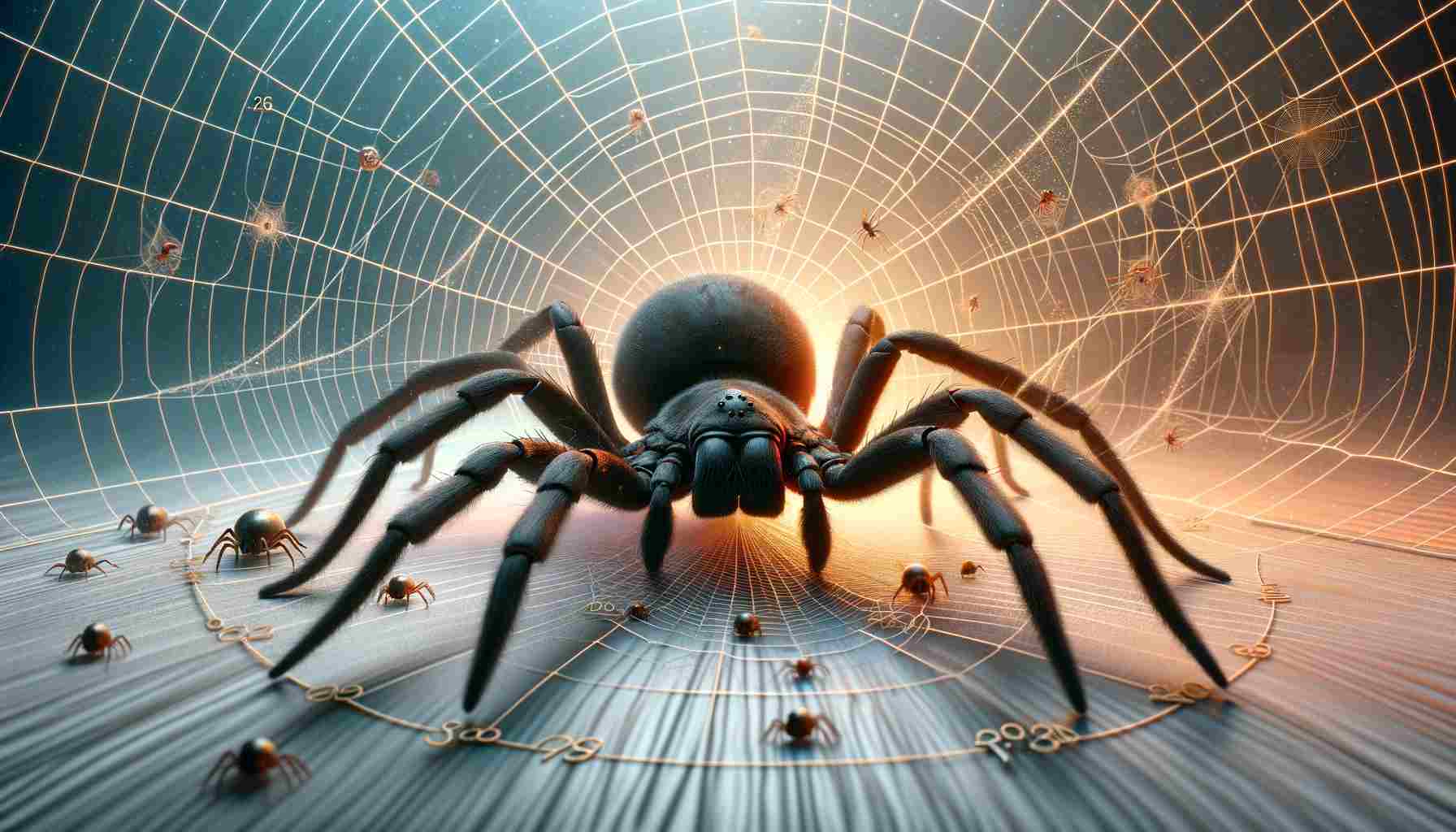
27, Dec 2023
Discovering the Lifespan of Black House Spiders
Experience the fascinating world of black house spiders, the invisible protectors of our houses, as you go on an in-depth investigation. This comprehensive book explores the unique elements of black house spider life, from their early stages as eggs to their expert web-weaving as adults, and answers the question, “How long do black house spiders live?”

Life Stages of Black House Spiders
Black house spiders, known scientifically as ‘Badumna insignis’, begin their journey as fragile, silk-encased eggs. These eggs, often hidden in secluded corners, hatch into spiderlings. As they grow into adults, these little spiders go through multiple molts, losing their exoskeletons. This transforming process, which is essential to their development, provides insight into the adaptability and durability of these spiders.
Spiderlings to Adulthood
- Molting Process: Spiderlings may go through multiple molts before reaching adulthood.
- Growth Rate: Several variables, including temperature, humidity, and the availability of food, affect the growth rate.

Factors Influencing Black House Spider Lifespan
Environmental Factors
- Humidity and Temperature: Black house spiders thrive in environments with stable humidity and temperature.
- Prey Availability: Their diet primarily consists of small insects, which plays a crucial role in their development and longevity.
- Predation Risks: They face threats from larger predators, including birds and larger spiders.
Human-Environment Impact
- Pesticide Exposure: Common household pesticides can significantly reduce their lifespan.
- Indoor vs. Outdoor: Spiders living indoors often experience different conditions that can either extend or shorten their life expectancy.
Survival Strategies and Aging Process
Black house spiders exhibit remarkable survival strategies. Their web-building is not just for catching prey but also serves as a defense mechanism against predators and environmental hazards. These spiders adjust their behavior based on age and environmental factors, providing insights into their aging process.
Web Weaving as a Survival Tool
- Strategic Placement: Webs are often constructed in high-traffic insect areas.
- Web Maintenance: Regular maintenance of their webs is vital for their survival.
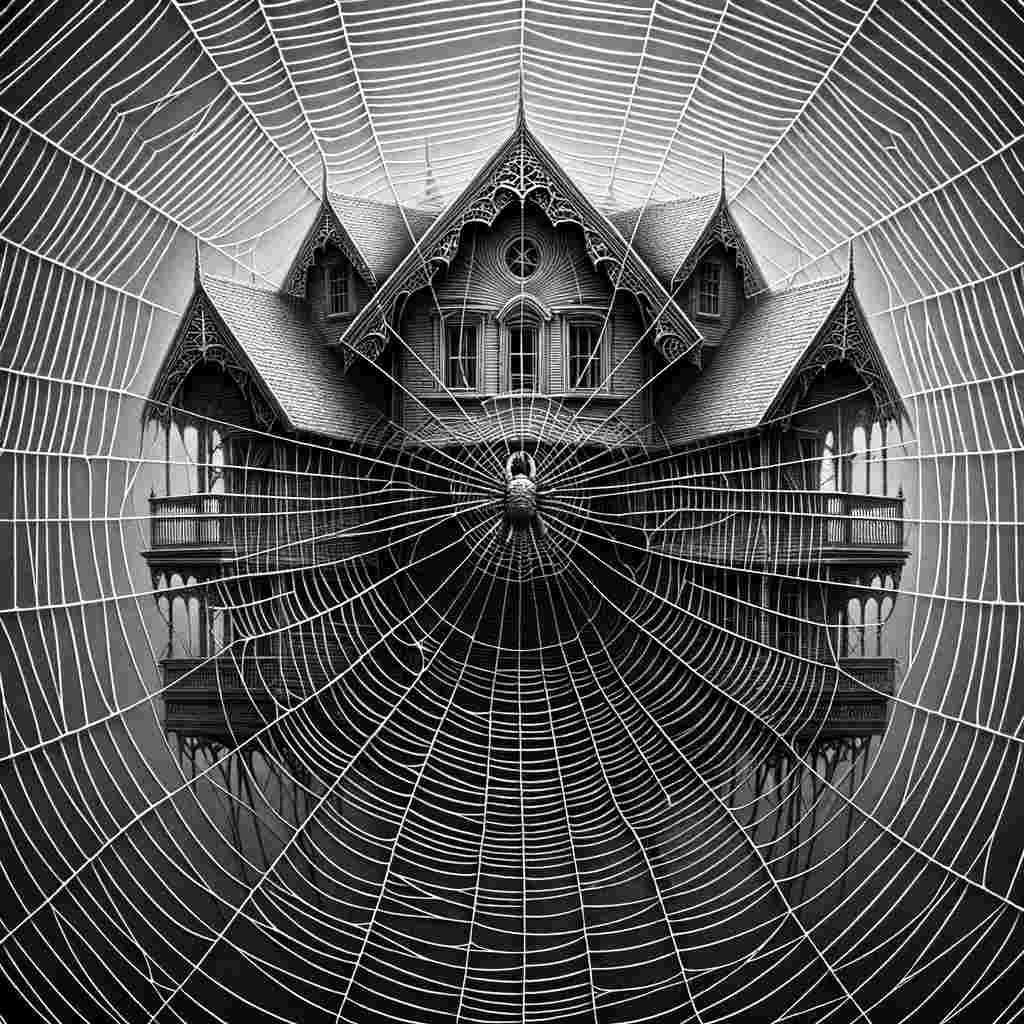
Environmental Impact on Black House Spider Life
The lifespan of black house spiders is heavily influenced by their immediate environment. In optimal conditions, with sufficient food and an ideal climate, they can live longer. On the other hand, unfavorable circumstances like low food or high temperatures might limit their life span.
Factors Affecting Lifespan in the Wild
- Natural Disasters: Events like floods or fires can destroy their habitats.
- Climate Change: Shifts in climate patterns can affect their natural lifecycle.
Average Lifespan: Estimations and Variability
The average lifespan of black house spiders is a subject of ongoing research. Generally, they can live for several years, with females often outliving males. Variations in lifespan are attributed to environmental factors, food availability, and threats from predators.
Human Interaction and Captivity Longevity
When black house spiders inhabit human dwellings, they often enjoy a safer environment, free from natural predators. This can lead to a longer lifespan compared to their outdoor counterparts.
Captivity Observations
- Controlled Environment: In captivity, with controlled conditions, their lifespan can extend significantly.
- Human Impact: Regular cleaning and human disturbance can, however, reduce their lifespan.
Conclusion:
In summary, the lifespan of black house spiders is a complex interplay of environmental factors, survival strategies, and adaptability. As we encounter these spiders in our homes, understanding their role in the ecosystem can foster appreciation and coexistence.






